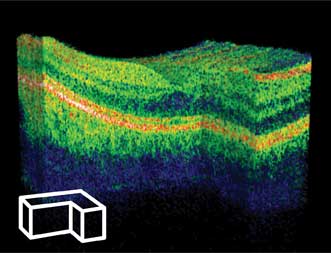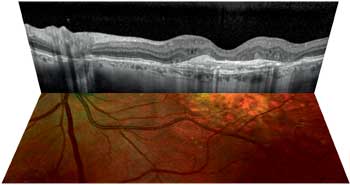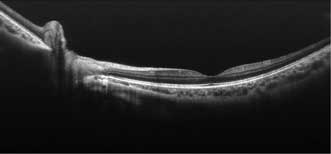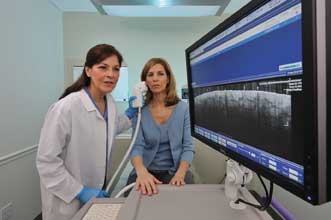A panel of industry experts weighs in on recent and future advances in optical coherence tomography, and offers a look at the market.
OCT is growing. As we reported in the July issue, the optical imaging market is set to reach $1.9 billion by the end of 2018 – a compound annual growth rate of 11.37 percent – and OCT makes up 70 percent or more of that market, according to a study by Research and Markets.
But if you only go by the numbers, you don’t get the whole story. Sure, 70 percent is great for OCT, but where is it really going? To get a more in-depth perspective, BioPhotonics interviewed representatives from companies that are big players in the OCT sphere: Jon Holmes, CEO of Michelson Diagnostics in Orpington, Kent, England; Douglas Malchow, manager of business development for the industrial sector at UTC Aerospace Systems (Sensors Unlimited Products) in Princeton, N.J.; and Dr. Kester Nahen, managing director of Heidelberg Engineering in Germany.

This retinal image was captured using UTC’s high-resolution InGaAs cameras for SD-OCT. Courtesy of UTC Aerospace Systems/Sensors Unlimited Products.
Michelson Diagnostics produces the VivoSight multibeam OCT scanner, which is used for dermatological applications, and makes high-resolution InGaAs cameras for spectral domain OCT and full-field OCT in the 1- to 1.6-µm- wavelength range. The cameras provide line-to-line phase stability for general, polarization-sensitive or Doppler imaging. Heidelberg Engineering specializes in diagnostic devices for ophthalmology applications, including the Spectralis product platform, which includes a spectral-domain OCT system with active eye tracking.
Q: What do you see as the “next big thing” in medical OCT, in general?
Holmes: I think the most important advance will be the availability of low-cost, high-bandwidth, swept-source lasers for OCT. The lack of availability of such devices is holding back the growth of the market for OCT generally, but I am aware of a number of devices that are being developed that look very promising.

The Spectralis product platform from Heidelberg Engineering includes a spectral-domain OCT (SD-OCT) system with active eye tracking for ophthalmology applications. Courtesy of Heidelberg Engineering.
Nahen: I see a lot of potential in multimodality imaging. The combination of OCT technology with other advanced imaging modalities – for example, for metabolic imaging – greatly enhances the diagnostic imaging armamentarium of ophthalmologists.
Malchow: There are many research groups investigating the application of OCT, by itself or in conjunction with other diagnostics, to detect early signs of disease in every type of tissue.
Even in the eye, where OCT has already had the most impact and become the gold standard, ultrahigh-resolution techniques are revealing more detail than previously recognized.
Dental OCT is promising, an improvement over x-rays for detecting early caries and offering the ability to monitor treatment efficacy periodically without the health concerns that limit x-ray imaging to two per year.
Q: How would you say the market has been in the past few years for OCT?

Standard SD-OCT image of a healthy retina, demonstrating a system with 6.1-mm imaging depth and 10-µm resolution. Image acquired with Sensors Unlimited GL2048L camera. Courtesy of University of Washington.
Holmes: The market has been picking up slowly. The clinical community is becoming more aware of the potential of OCT in many applications outside ophthalmology. I think the market will accelerate.
Malchow: As a relatively new diagnostic, OCT is still early in its acceptance, and has to make its way into the office business model by demonstrating that reimbursement for its usage improves health outcomes and lowers total health care costs. Developing that evidence takes time, but results in long-term, steady growth.
The expanding base of tissue applications ensures the development of a very strong industry of component and systems providers, trainers, imaging technicians and database managers.
Nahen: Thanks to the availability of new therapies for eye diseases, the market for OCT grew strongly in the past few years. New therapeutic options for different diseases that will become available within the next few years will evoke an even greater demand for advanced diagnostic systems.
Q: What are the biggest challenges to clinical adoption of OCT?
Malchow: Demonstrating efficacy and diagnostic clarity over well-established and trusted methods of long standing. Old methods will not be dropped unless there is a compelling advantage to the new techniques.
Nahen: The technological advances of OCT technology in the last few years [has led to] a big demand for comprehensive training of users.

The VivoSight multibeam OCT scanner from Michelson Diagnostics is used for dermatological applications. Courtesy of Michelson Diagnostics.
Holmes: Each individual clinical application will only develop once there are products available with regulatory approval, and also clear clinical benefits. It is not enough to have interesting images from laboratory prototypes. Clinicians will only adopt OCT once they see why it is useful in terms of improving patient outcomes, and when the device is easy to use and the methods of use well-developed.
A second major barrier is lack of reimbursement, especially in the US. No reimbursement means that clinicians cannot get paid for a scan even though it is obviously cheaper/quicker to do and better for the patient, but getting a new reimbursement code is a lot of work!
Q: And which application areas would you say are thriving – and why?
Holmes: [We are] experiencing very promising growth in dermatology, especially for the diagnosis and monitoring of treatment of nonmelanoma skin cancer. This is a very common condition, and patients are keen to be scanned to avoid biopsy, especially when noninvasive treatments are potentially appropriate.
We have a growing clinical user base in our core market of Germany, and are expanding sales into other countries including Switzerland [and] Australia. Our products are also proving very popular for dermatological research by pharmaceutical and cosmetic product companies globally.
Malchow: Ophthalmology is very healthy, with active competition and product development. Cardiovascular and other types of endoscopy are still in early development as major markets. Optical diagnostics in dentistry are in their infancy, with few of the research dentists aware of the potential value.
Nahen: Initial diagnosis and monitoring of [age-related macular degeneration] patients [is] one of the thriving application areas, due to the availability of anti-VEGF (anti-vascular endothelial growth factor) medication. Together with other advanced imaging modalities like BluePeak autofluorescence and Multi-Color laser scanning imaging, monitoring of patients at risk of developing eye diseases is an important application area.